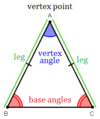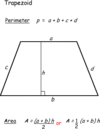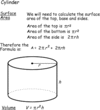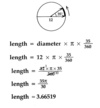Math Review Flashcards
(140 cards)
If an integer b is not a divisor of a, then the result can be viewed in 3 diff ways…
If an integer b is not a divisor of a, then the result can be viewed in 3 diff ways…
1) A fraction
2) A decimal
3) A quotient with remainder
The product of two positive integers is…
The product of two positive integers is a positive integer
The product of two negative integers is…
The product of two positive integers is a positive integer
The product of a positive integer and negative integer is…
The product of a positive integer and negative integer is a negative integer
Each of the multiplied integers that result in a product
Factor/Divisor
When an integer *a * is divided by an integer b, where *b * is a divisor of *a, *the result is always
When an integer a is divided by an integer b, where b is a divisor of a, the result is always
A divisor of a
EX: When 60 is divided by 6(one of its divisors), the result is 10, which is another divisor of 60
When a positive integer a is divided by a positive integer *b, you first find the first greatest multiple of b that is less than or equal to a. That multiple of b can be expressed as the product qb(where q is quotient). Then the remainder is equal a *minus that multiple of b, or r = a - qb, where *r *is the remainder.
The remainder is always greater than or equal 0 and less than b.
When a positive odd integer is divided by 2…
When a positive odd integer is divided by 2…
The remainder is always 1
To divide one fraction by another…
To divide one fraction by another…
First invert the second fraction(i.e. find it’s reciprocal), then multiply the first fraction by the inverted fraction.
17/8 ÷3/4 = (17/8)(4/3) = (4/8)(17/3) = (1/2)(17/3) = 17/6
Numbers of the form a/b, where either *a *or b is not an integer and b NE 0, are fractional expressions that can be manipulated just like fractions.
EX: Numbers π/2 and π/3 can be added as:
π/2 + π/3 = (π/2)(3/3) + (π/3)(2/2) = (3π/6)(2π/6) = 5π/6
Exponents are..
Exponents are..
Used to denote the repeated multiplication of a number by itself.
-Remember the base **and exponent
A negative number raised to an odd power…
A negative number raised to an odd power..
is always negative
NOTE: The exponent is applied before the negative sign when you have an expression with exponents
Without parentheses the expression -32 means “the negative of ‘3 squared.’” So (-3)2= 9,
but -32 = -9
All positive numbers have two square roots, one positive and one negative
The symbol √n is used to denote the nonnegative square root of the nonnegative number n.
Therefore, √100 = 10 and –√100 = –10
(– √a)2 =
(– √a)2 = a
(– √3)2= 3
√a2=
√a2 = a
√π2 = π
√a√b =
√a√b = √ab
√3√10 = √30
√a/√b =
√a/√b = √a/b
√18/√2 = √18/2 = √9 = 3
For odd-order roots
For odd-order roots, there is exactly one **root for every number n, even when n is negative.
EX: 8 has exactly one cube root, 3√8 = 2
and –8 has exactly one cube root, 3√–8 = –2
For even-order roots
For even-order roots, there are exactly two roots for every positive number n and **no roots **for any **negative **number n.
EX: 8 has two fourth roots, 4√8 and –4√8,
but -8 has no fourth root, since it is negative
All rational numbers and irrational numbers, including all integers, fractions and decimals.
Real number
If a + b = b + a, then
If a + b = b + a, then ab = ba
EX: 8 + 2 = 2 + 8 = 10
and (-3)(17) = (17)(-3) = -51
If (a + *b) + c = a + (b* + c), then
If (a + b) + c = a + (b + c), then (ab)c = *a(bc*)
EX: (7 + 3) + 8 = 7 + (3 + 8) = 18,
and (7√2) √2 = 7(√2√2) = (7)(2) = 14




























